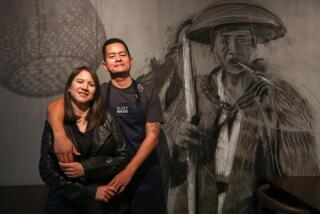Japanese Firms Should Show Some Civic Responsibility
After Japanese Prime Minister Yasuhiro Nakasone was quoted as making demeaning remarks about American minorities, most of his critics in this country agreed that he had inadvertently exposed a characteristic Japanese nationalism, arrogance and racism.
Nakasone and all citizens of Japan were damned in the American press. Great pressure was brought by Congress for Nakasone to take back his remarks. When he apologized on Sept. 27, the incident was officially over, leaders of the two nations returned to their thorny trade problems and the story disappeared from the news.
In some parts of this country it may be that five days of moral outrage followed by a contrite apology were just about right. But not in Southern California.
Our area now is approximately 10% black, 14% Asian-Pacific, 32% Latino and 44% Caucasian. More than 800 Japanese companies are located here, and we all have to live together.
People like James Fallows, writing in the September issue of the Atlantic Monthly, may be comfortable with the observation that “the Japanese have obviously profited, in purely practical terms, from their racial purity.” It is this kind of intellectual sleight of hand that permits some people to conclude that their regional economies--say, in the Northeast or the Midwest--are in trouble because, unlike the Japanese, they have too many races.
But Southern California defies that logic. We have the most vigorous regional economy in the United States, we have the most buoyant and optimistic outlook on our future and we also have the most ethnically diverse population in America. Did this happy circumstance come about by chance? Is it that the people of our region are genetically more disposed toward racial harmony than are those elsewhere? Or is it perhaps the fact that we have had political leaders of all races, labor leaders and business leaders of vision and community organizations that have worked hard to see to it that we keep our community together?
The weight of urban sociology leads to the conclusion that any city, as it grows, will encounter difficulty in maintaining a sense of community within its increasingly heterogeneous population. The social glue is provided by “intermediate” institutions --the groupings of human beings that are larger than a neighborhood but smaller than a metropolis: the Girl Scouts, the Boys’ Clubs, the YWCA, the United Way. Without thousands of volunteers and millions of donors, a region like ours cannot produce the kind of community that gives life to democracy and to free enterprise. Whether or not Nakasone is aware of this is not our business. Whether the companies of Japan that enjoy the fruits of this U.S. democracy understand this, however, is very much our business.
Now is the time for the 800 Japanese companies of Southern California and the tens of thousands of U.S. citizens for whom they provide welcome employment to commit themselves to participate fully in maintaining this society. They provide jobs--as do ARCO, Lockheed and General Telephone. They pay taxes--as do Security Pacific Bank and Southern California Gas. But, unlike these aforementioned companies, the Japanese companies have been slow to give of their time and money to support charitable organizations, slow to undertake aggressive affirmative-action programs and slow to reach out to minority small-business vendors. And executives from Japan have been all but invisible on the volunteer committees and boards that make our region a success.
There are exceptions, and these are to be applauded for their participation. Some Japanese companies have given money to local causes while others have given of their time. In many cases established local business and civic leaders have been slow to invite participation by Japanese business leaders. On the whole, however, it must be said that the Japanese business community of Southern California has yet to accept the civic responsibility that American democracy demands of its business community.
Leaders of the Asian-Pacific American community of Southern California have joined together in an organization called Leadership Education for Asian-Pacifics, or LEAP. Setting aside the centuries-old rivalries of their ancestors, the Filipino, Korean, Chinese, Vietnamese, Japanese, Cambodian, Samoan and other ethnic groups have joined together to oppose racism on every front. In America, and above all in California, we respond to people who are new and different by finding a way to bring them in. We are not naive about the process, and the process isn’t easy. It is, however, necessary.
Leaders of the Japanese business community in Southern California must stop acting like visitors bearing jobs and start acting more like what they should be: a central part of the economic, social and moral life of our community. This is the way to prove that the racist sentiments that were implied in Nakasone’s comments cannot be ascribed to all Japanese, and to settle the issue in this melting pot of the Pacific Rim.
More to Read
Inside the business of entertainment
The Wide Shot brings you news, analysis and insights on everything from streaming wars to production — and what it all means for the future.
You may occasionally receive promotional content from the Los Angeles Times.










